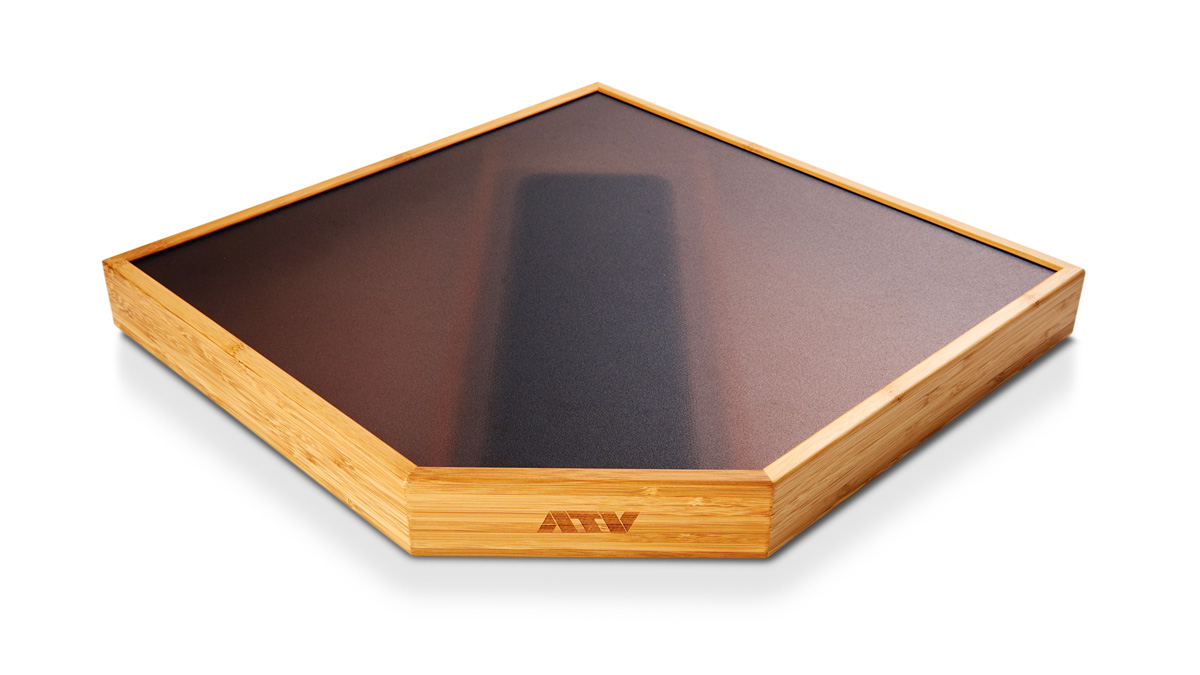MusicRadar Verdict
The aFrame embodies the missing link between acoustic and electronic percussion instruments.
Pros
- +
Incredible amount of editing options…
Cons
- -
…but you may need sometime explore them and get the best out of the aFrame.
MusicRadar's got your back
Despite having only recently released the aD5 drum module, Japanese audio-visual company ATV Corporation hasn’t wasted any time in following it up, unveiling a brand new electronic percussion instrument called the aFrame.
With the support of world-renowned percussionists Pete Lockett (Björk, Peter Gabriel) and Karl Vanden Bossche (Gorillaz, Jamiroquai), ATV is ushering in a new era of ‘elecro-organic’ percussion.
Build
The aFrame’s square-shaped ‘frame’ is constructed from natural bamboo, with one corner cut off, giving it a unique, diamond-like appearance. Each of the frame’s corners have been hand-joined using traditional Japanese techniques for a clean and natural look.
The playing surface is a slightly translucent grey polycarbonate material with a matte feel, similar to a coated drum head. On the back, the module element of the aFrame runs vertically down the middle. Finished in gloss black plastic, the module features a small LCD screen at the top (sandwiched between left and right cursor buttons), a rotary wheel that doubles as a button (or ‘encoder’ as it is described) and two rows of five LED-lit navigation buttons.
These are marked pitch, decay, bend, volume and effect on the left, and A, B, C, D and function on the right. Just underneath these buttons is a micro-SD card slot for data storage. There is a camera tripod thread in the centre that can be used to mount the aFrame to a stand or strap, although it will also fit very comfortably in a snare stand. Ultimately though, the ATV aFrame is designed to be used as a hand-held instrument.

Rather than simply triggering sampled sound sources, the aFrame utilises two inbuilt piezo mics (centre and edge), enabling it to process sounds produced by a player’s bare hands using a DSP (digital signal processor) in real-time. This DSP is based on ATV’s proprietary ‘Adaptive Timbre Technology’, which is described as “an innovative technology that produces diverse tones by modifying the harmonic makeup of the signal input”. In addition to the mic pickups, the aFrame also has an in-built pressure sensor, which opens the instrument up to additional expression and more detailed playing techniques.
In terms of connectivity, the bottom of the module features a headphone mini-jack, left and right 1⁄4" jack line-outs, a 5v DC power port and a mini-USB port (for computer connectivity and USB battery power). The power button also doubles as a handy mute switch when tapped. There will be an ATV-branded, 4600mAh power bank coming in the near future, which we’re told will power the aFrame for up to 15 hours.
Want all the hottest music and gear news, reviews, deals, features and more, direct to your inbox? Sign up here.
Hands on
While it might appear fairly basic at first glance, it soon becomes apparent that the aFrame is far from it. However, our initial navigation experience is very straightforward.
Each lettered button calls up a group of 10 different tones, while the left and right buttons are used to cycle through them. This means a total of 40 stock tones, but there’s ample built-in memory for user-tones, and many more can be enabled via the micro-SD slot.
The four groups of supplied tones are categorised by Neo-acoustic, Acoustic, Electronic and Effect. The sounds vary from beautifully natural acoustic percussion instruments like cajons and taiko drums, through to beefy overdriven bass-synths and bonkers electro-percussion effects.
The head is amazingly responsive and has an enormous dynamic range, from the smallest scratch to the heaviest slap. Even the bamboo frame itself can be tapped and scraped to illicit equally dynamic sounds. The aFrame really does respond impressively, like an acoustic instrument and it’s amazingly immersive once you get stuck in.
While it might appear fairly basic at first glance, it soon becomes apparent that the aFrame is far from it
The parameter buttons to the left of the module, along with the encoder, can be used to adjust settings on-the-fly, such as pitch, volume, effect level, decay and bend. These settings are not saved automatically, which is useful for quick performance changes. At this level, we happily spent days experimenting and were constantly blown away by the vast intricacies in sound that could be achieved from just a single tone.
We did, however, experience some difficulty creating the same notes consistently and it was when we went deeper into the manual that the depth of the aFrame’s capabilities became clear.
On a basic level, ATV describes a ‘tone’ as the combination of an instrument and an effect. These elements can be mixed and matched easily to create new tones before you even venture into the vast editing menus. But it turns out that each instrument is made up of four separate component ‘timbres’ which, of course, are fully customisable.
Not only is it possible to completely change the initial note, pitch and decay, mix and pan, and apply individual levels of effect to each timbre, but also instruct each one to react more or less from the centre or the edge pickup. You can even tell each individual layer to mute, pitch bend or control effect levels via the pressure sensor.
This degree of editing on the aFrame is truly phenomenal, and it would make a great instrument for percussionists, or even producers, who are searching for new sounds and craving an expressive new instrument for their recordings or live performances.
Tom is a professional drummer with a long history of performing live anywhere from local venues to 200,000 capacity festivals. Tom is a private drum tutor, in addition to teaching at the BIMM Institute in Birmingham. He is also a regular feature writer and reviewer for MusicRadar, with a particular passion for all things electronic and hybrid drumming.

